Kubernetes Networking Deep Dive
Network Security
CNI Network Policies Overview
Recap of Kubernetes Network Policies
By default, Kubernetes pods communicate without restrictions, which can expose applications to unintended traffic flows. Implementing network policies allows you to explicitly permit or deny traffic between:
- Pod-to-Pod
- Pod-to-Service
- Pod-to-Namespace
Note
Network policies enhance cluster security by defining clear ingress and egress rules. Always start with a default deny posture in production.
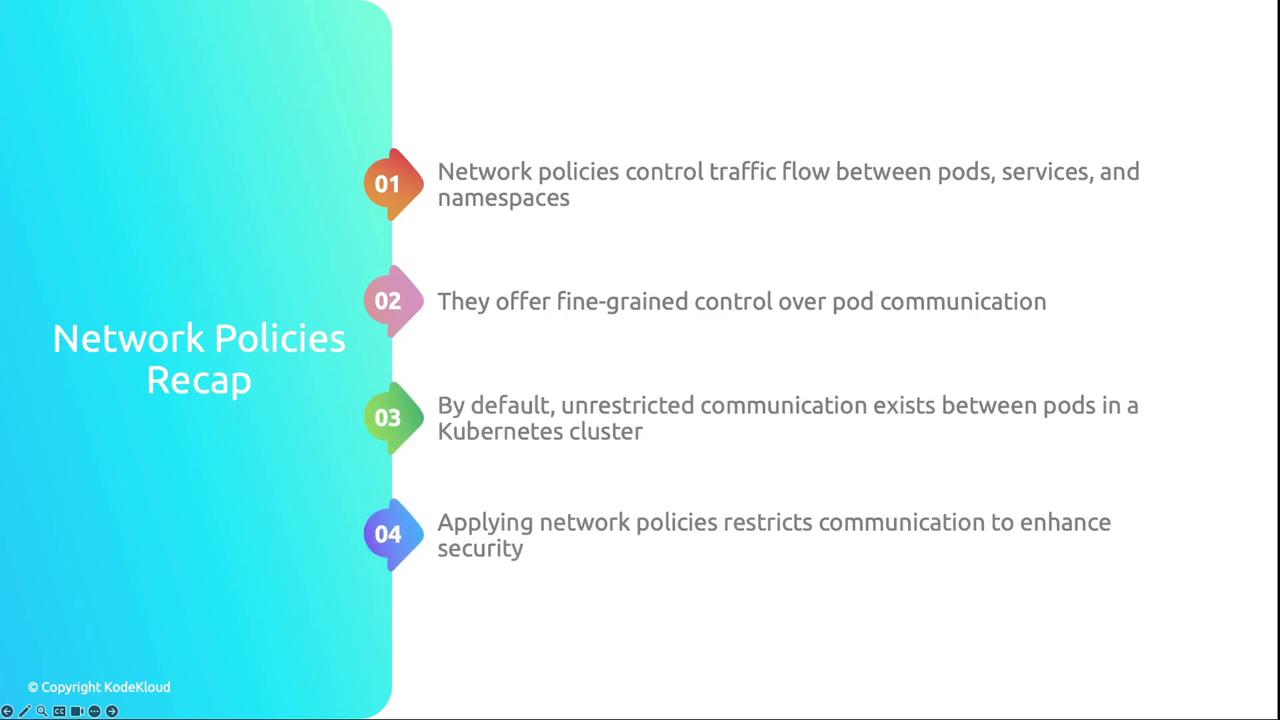
Built-In vs. CNI-Specific Network Policies
Kubernetes ships with basic network policy support, but many CNI plugins extend capabilities with advanced features:
| Feature | Built-In Policy | CNI Plugin Extensions |
|---|---|---|
| Layer 7 Filtering | ✖️ | ✅ HTTP, gRPC, Kafka rules |
| Encryption & Segmentation | ✖️ | ✅ mTLS, IPsec |
| Rate Limiting & Whitelisting | ✖️ | ✅ IP whitelisting/blacklisting, QoS |
| Traffic Monitoring & Analytics | Limited | ✅ Real-time metrics & logs |
| Multi-Cluster Policy Scope | ✖️ | ✅ Global policy management |
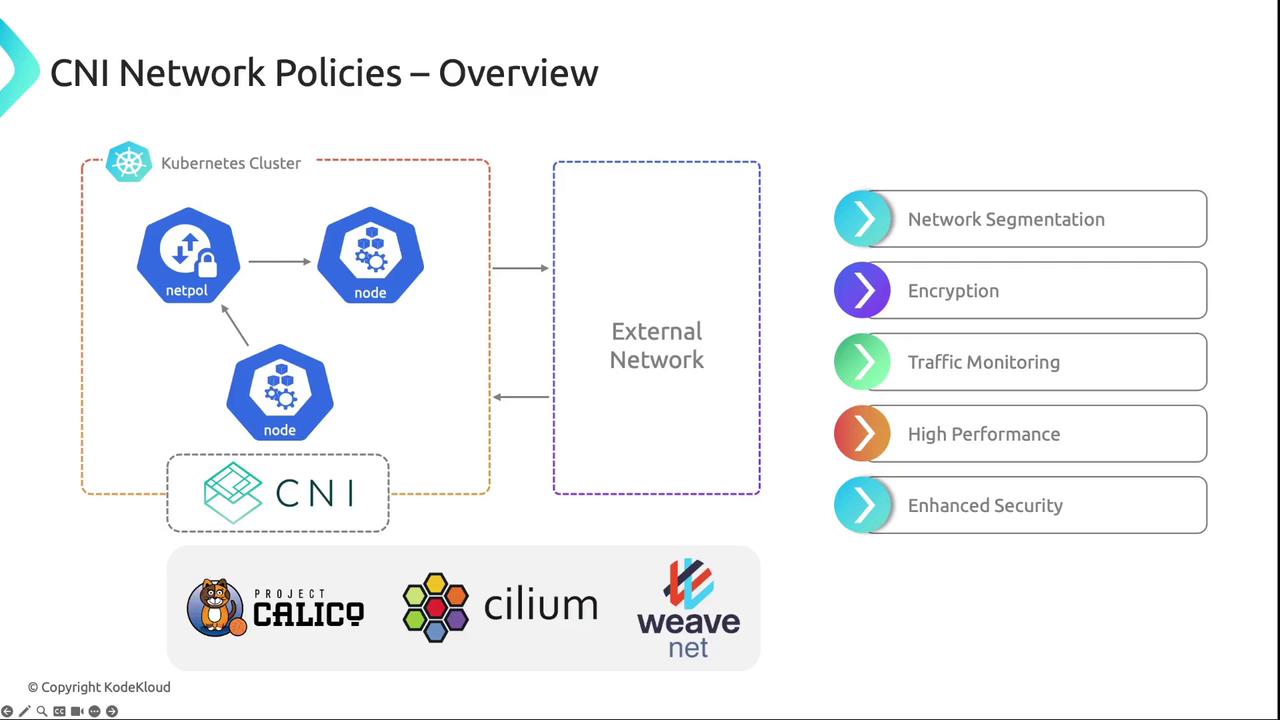
Key Benefits of CNI Network Policies
| Benefit | Description |
|---|---|
| Advanced Traffic Control | Fine-grained L3–L7 rules across pods, nodes, external targets |
| Enhanced Security | Intrusion detection, IP whitelisting, rate limiting |
| Performance Optimization | Low-latency, high-throughput networking |
| Extended Scope | Policy enforcement beyond cluster boundaries |
| Customization | Organization-specific rule definitions |
| Segmentation & QoS | Network isolation plus traffic prioritization |
| Real-Time Monitoring | Anomaly detection and live metrics |
Cilium: Our CNI of Choice
Cilium leverages eBPF for efficient enforcement of Layer 3, 4, and 7 policies with minimal performance overhead:
- Layer 7 Visibility (HTTP, gRPC, Kafka)
- Protocol-Aware Filtering (methods, paths, headers)
- Service Mesh Integrations (Istio, Linkerd)
- Multi-Cluster Policy Consistency
- Rich eBPF-Powered Troubleshooting & Metrics
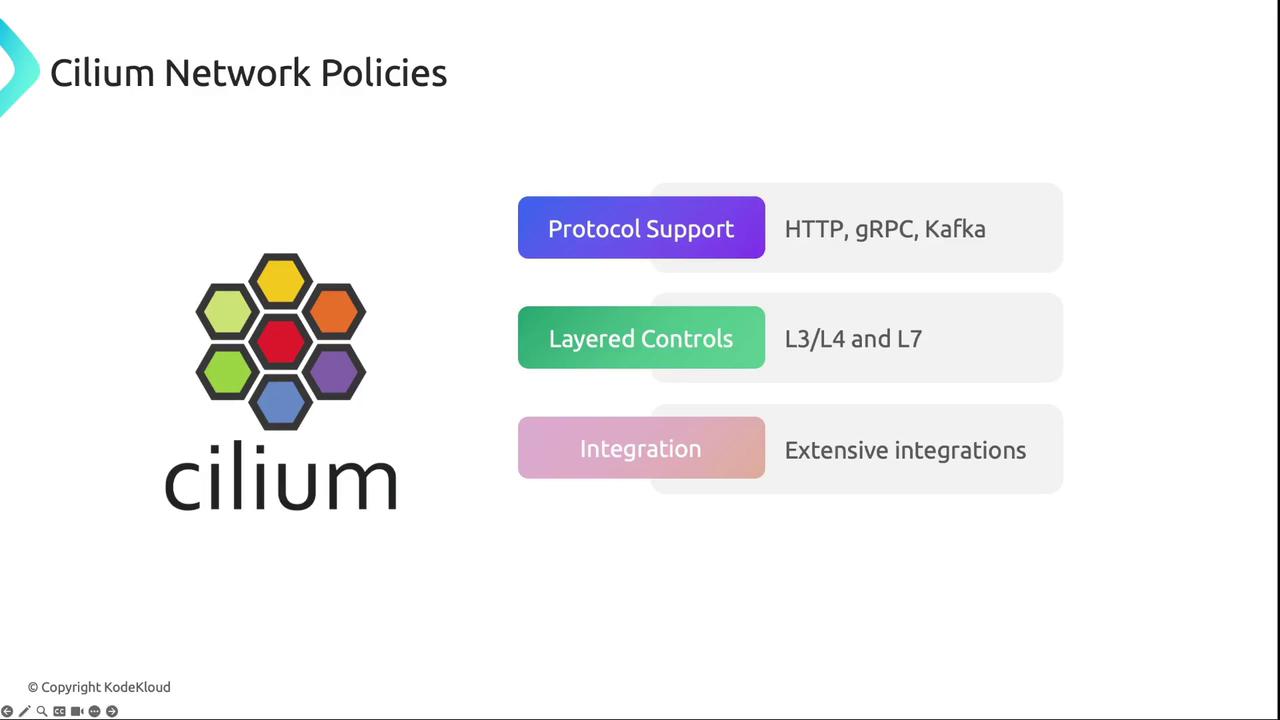
Policy Enforcement Modes
Cilium follows a whitelist model. Traffic is dropped by default unless permitted by one of these modes:
- Ingress Policies: Allow traffic into pods based on source IPs, ports, or L7 rules
- Egress Policies: Allow pods to initiate traffic to specified destinations
- Default Deny: Any traffic not explicitly allowed will be blocked
Rule Structure
Every Cilium policy uses an endpoint selector to target pods via labels:
endpointSelector:
matchLabels:
app: myapp
Subsequent rule sections can include:
fromEndpoints/toEndpoints: Label selectors for source/destination podsports&protocols: Restrict to TCP/UDP ports- Layer 7 rules: HTTP methods, paths, headers
- CIDR blocks: Allow or exclude specific IP ranges

Example: Comprehensive CiliumNetworkPolicy (L3–L7)
apiVersion: "cilium.io/v2"
kind: CiliumNetworkPolicy
metadata:
name: "example-policy"
spec:
endpointSelector:
matchLabels:
app: myapp
ingress:
- fromEndpoints:
- matchLabels:
app: frontend
toPorts:
- ports:
- port: "80"
protocol: TCP
rules:
http:
- method: "GET"
path: "/public"
egress:
- toEndpoints:
- matchLabels:
app: database
toPorts:
- ports:
- port: "3306"
protocol: TCP
- Ingress: Only HTTP GET on
/publicfrom pods withapp=frontend. - Egress: Only TCP port 3306 to pods with
app=database.
Layer 3 Policies
Layer 3 policies define network-layer connectivity without deep packet inspection:
- Endpoints-based: Select pods by labels
- Entities-based: Match built-in identities like
hostorworld - DNS-based: Use runtime-resolved DNS names (honoring TTLs)
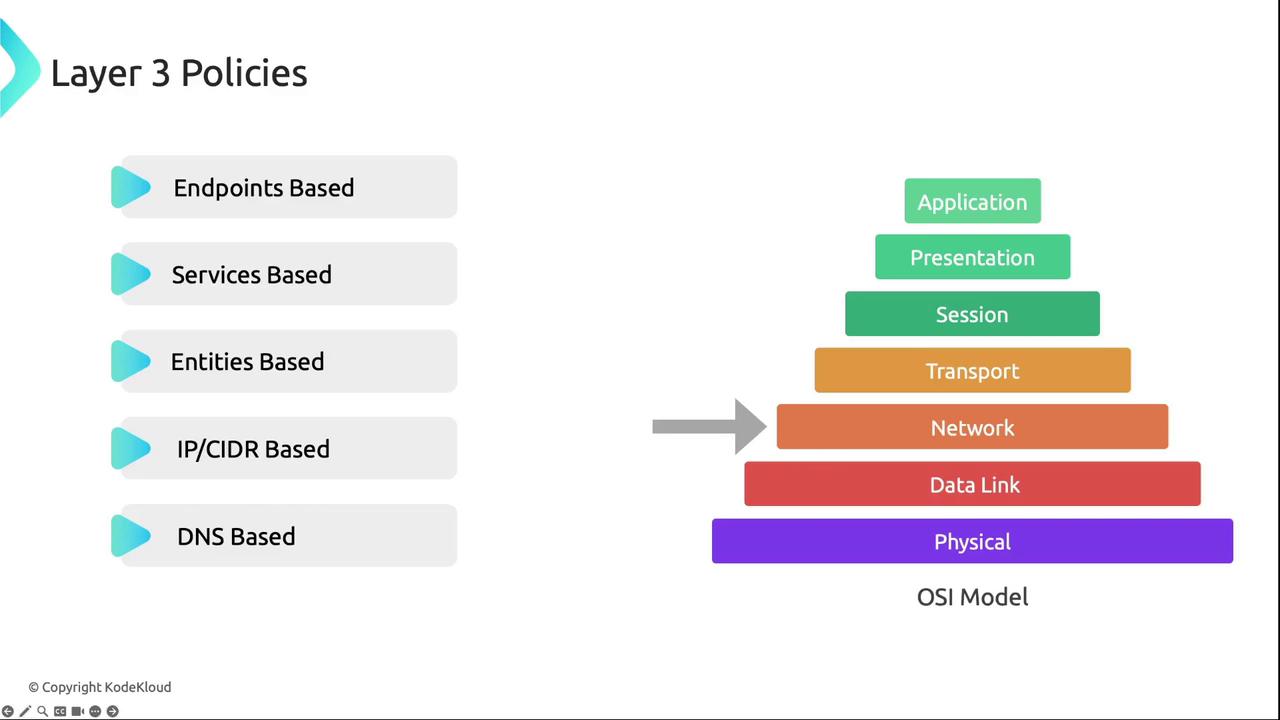
Examples
# 1. Allow ingress from frontend pods to backend pods
apiVersion: "cilium.io/v2"
kind: CiliumNetworkPolicy
metadata:
name: layer3-ingress-only
spec:
endpointSelector:
matchLabels:
role: backend
ingress:
- fromEndpoints:
- matchLabels:
role: frontend
# 2. Allow egress to specific CIDRs, excluding cluster service CIDR
apiVersion: "cilium.io/v2"
kind: CiliumNetworkPolicy
metadata:
name: layer3-egress-cidr
spec:
endpointSelector:
matchLabels:
role: backend
egress:
- toCIDR:
- "20.1.1.1/32"
- toCIDRSet:
- cidr: "10.0.0.0/8"
except:
- "10.96.0.0/12"
Layer 4 Policies
Layer 4 rules govern transport-layer connectivity (TCP/UDP). By default, Cilium blocks ICMP unless explicitly permitted.
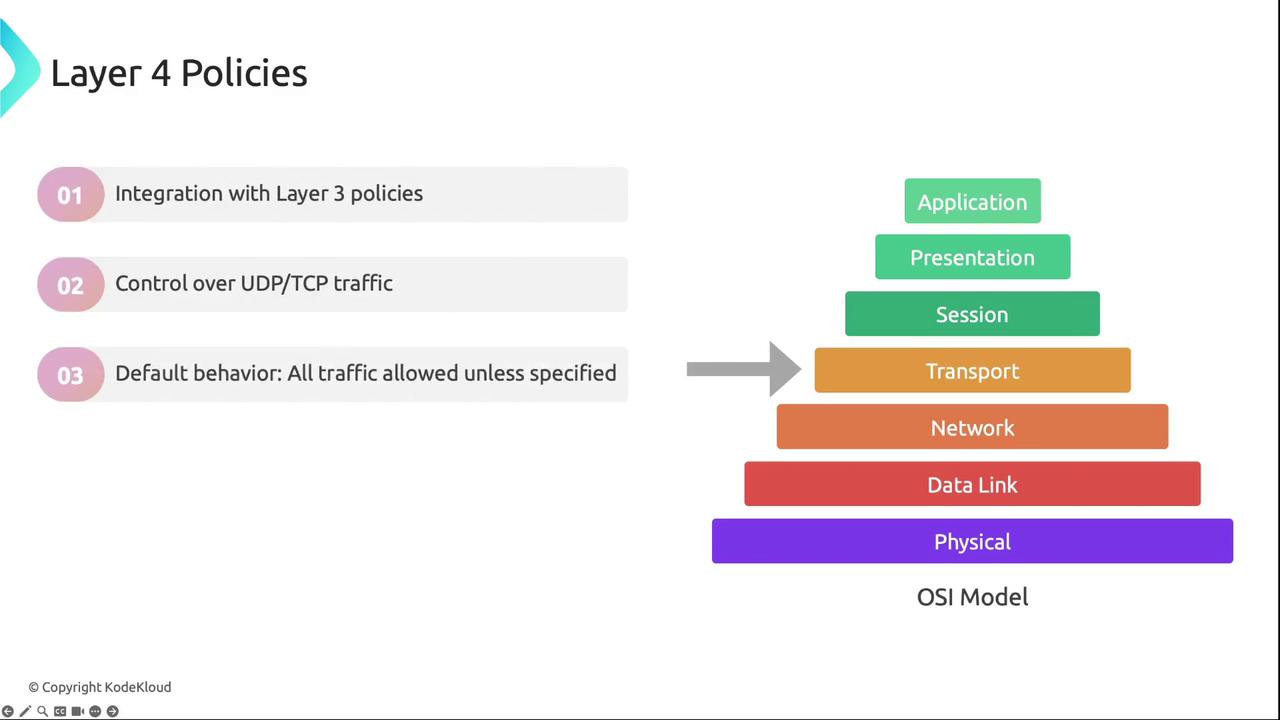
Example: Restrict Egress to TCP Port 80
apiVersion: "cilium.io/v2"
kind: CiliumNetworkPolicy
metadata:
name: layer4-example
spec:
endpointSelector:
matchLabels:
app: myService
egress:
- toPorts:
- ports:
- port: "80"
protocol: TCP
This policy permits only TCP traffic on port 80 for pods labeled app=myService.
Layer 7 Policies
Layer 7 policies enable application-layer inspection and enforcement for HTTP, gRPC, Kafka, and more.
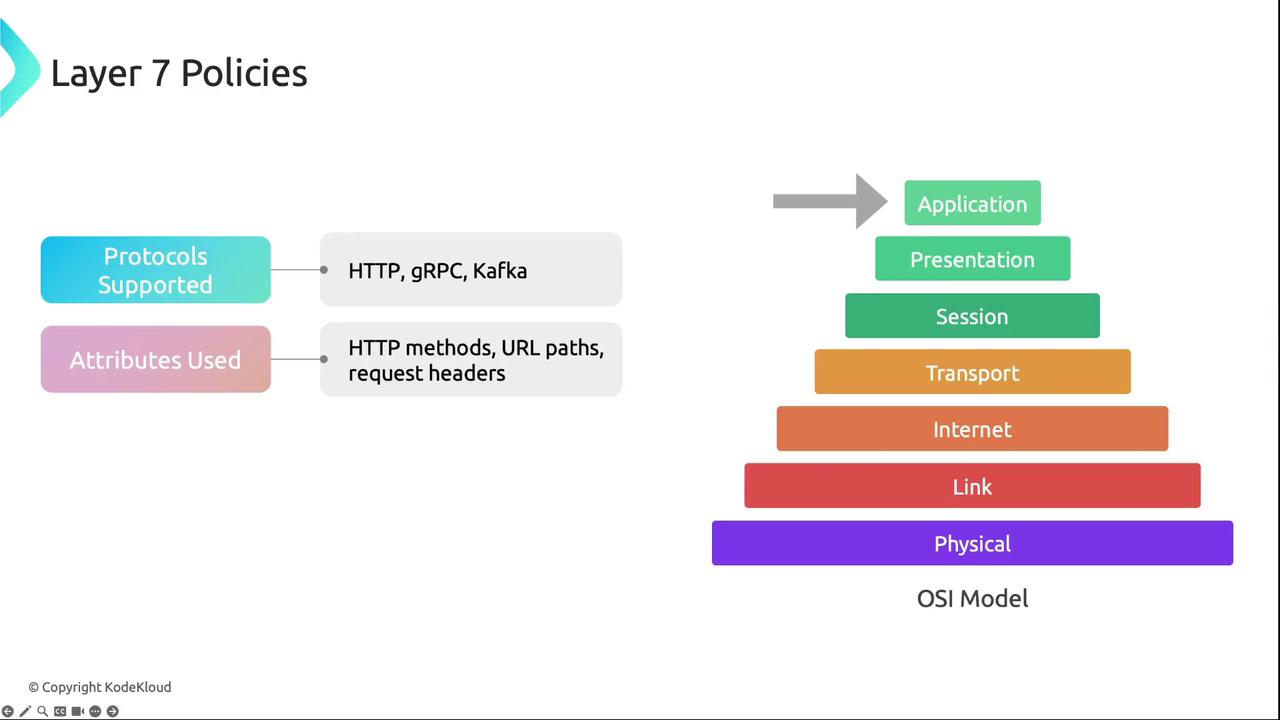
Example: HTTP Methods, Paths & Headers
apiVersion: "cilium.io/v2"
kind: CiliumNetworkPolicy
metadata:
name: layer7-example
spec:
endpointSelector:
matchLabels:
app: myService
ingress:
- toPorts:
- ports:
- port: "80"
protocol: TCP
rules:
http:
- method: GET
path: "/path1$"
- method: PUT
path: "/path2$"
headers:
- "X-My-Header: true"
This policy allows:
- HTTP GET requests to
/path1 - HTTP PUT requests to
/path2only ifX-My-Header: trueis present
Namespace vs. Cluster-Wide Policies
Cilium supports two scope levels:
| Resource Type | Scope |
|---|---|
| CiliumNetworkPolicy | Single Namespace |
| CiliumClusterwideNetworkPolicy | All Namespaces |
Note
Combining namespace-specific and cluster-wide policies ensures both granular control and consistent, global security enforcement.
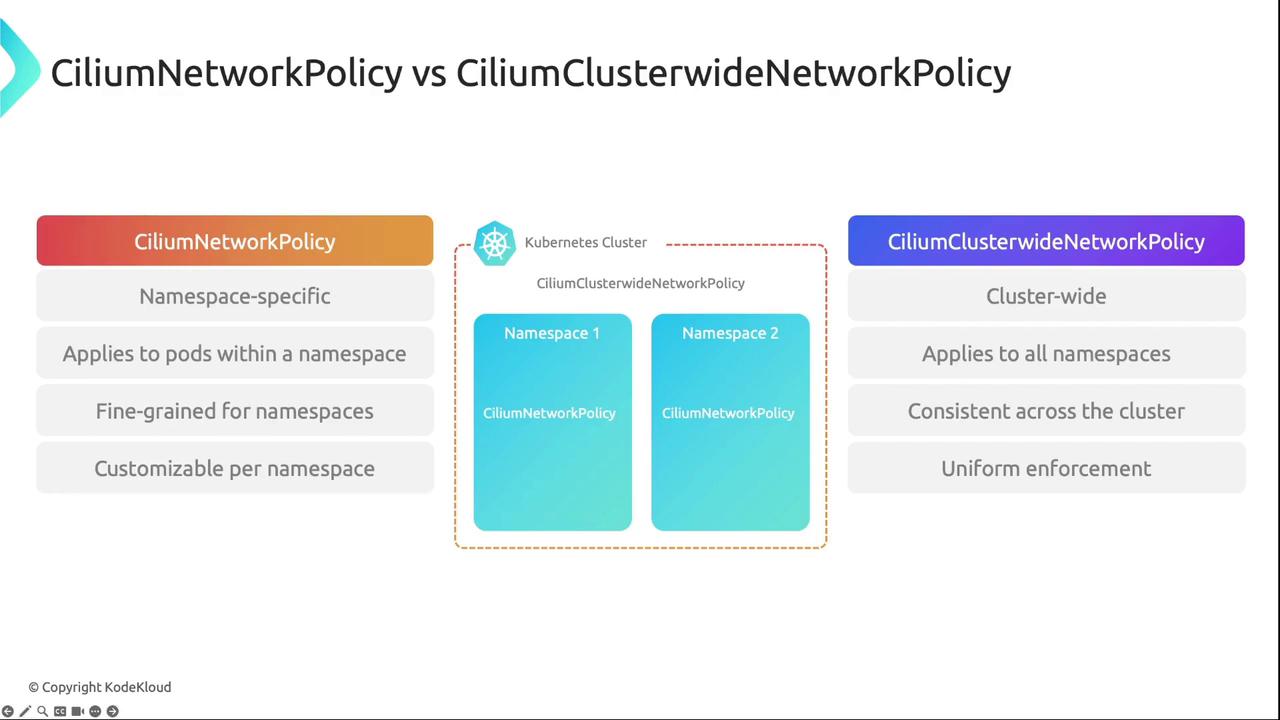
Now that we’ve covered the theory behind CNI network policies, explore our hands-on Cilium policy lab to see them in action.
Links and References
- Kubernetes Network Policies
- Cilium Documentation
- Calico Networking
- Weave Net
- Istio Service Mesh
- Linkerd Service Mesh
Watch Video
Watch video content